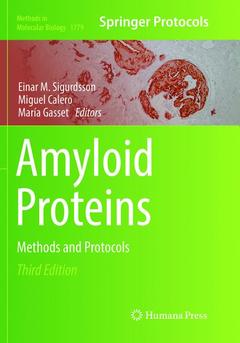Amyloid Proteins (3rd Ed., Softcover reprint of the original 3rd ed. 2018) Methods and Protocols Methods in Molecular Biology Series, Vol. 1779
Coordonnateurs : Sigurdsson Einar M., Calero Miguel, Gasset María

Preface…
Table of Contents…
Contributing Authors…
Part I: In Vitro Models and Assays
1. Preparation of Pure Populations of Amyloid-β Protein Oligomers of Defined Size
Eric Y. Hayden, Joseph L. Conovaloff, Ashley Mason, Gal Bitan, and David B. Teplow
2. Preparation of Well-Defined and Stable β-Barrel Pore-Forming Amyloid-β42 Oligomers
Montserrat Serra-Batiste, Martí Ninot-Pedrosa, Eduard Puig, Sonia Ciudad, Margarida Gairí, and Natàlia Carulla
3. Unveiling Brain Aβ Heterogeneity through Targeted Proteomic Analysis
Agueda Rostagno, Thomas A. Neubert, and Jorge Ghiso
4. Preparation of α-Synuclein Amyloid Assemblies for Toxicity Experiments
Serene W. Chen and Nunilo Cremades
5. Generation and Characterization of Stable α-Synuclein Oligomers
Leire Almandoz-Gil, Martin Ingelsson, and Joakim Bergström
6. In Vitro Analysis of α-Synuclein Amyloid Formation and Cross-Reactivity
Istvan Horvath, Sandra Rocha, and Pernilla Wittung-Stafshede
7. Preparation of Tau Oligomers after Protein Extraction from Bacteria and Brain Cortices
Elentina K. Argyrousi, Agnieszka Staniszewski, Russell E. Nicholls, and Ottavio Arancio
8. Purification and Characterization of Low-n Tau Oligomers
Senthilvelrajan Kaniyappan, Ram Reddy Chandupatla, and Eckhard Mandelkow
9. Preparation and Characterization of Tau Oligomer Strains
Urmi Sengupta, Mariana Carretero-Murillo, and Rakez Kayed
10. Purification and Fibrillation of Recombinant Human Amyloid-β, Prion Protein and Tau under Native Conditions
Alexander Sandberg and Sofie Nyström
11. Preparation of Amyloidogenic Aggregates from EF-Hand β –parvalbumin and S100 Proteins
Javier Martínez, Joana S. Cristóvão, Rosa Sánchez, Maria Gasset , and Cláudio M. Gomes
12. Kinetic Analysis of Amyloid Formation
Georg Meisl, Thomas C.T. Michaels, Sara Linse, and Tuomas P. J. Knowles
13. Mapping Amyloid Regions in Gad m 1 with Peptide Arrays
Rosa Sánchez, Javier Martínez, Laura Montoya, Milagros Castellanos, and Maria Gasset
14. Non-Invasive Structural Analysis of Intermediate Species during Fibrillation: An Application of Small-Angle X-Ray Scattering
Annette Eva Langkilde, Fátima Herranz-Trillo, Pau Bernadó, and Bente Vestergaard
15. Analysis of Covalent Modifications of Amyloidogenic Proteins using Two-Dimensional Electrophoresis: Prion Protein and Its Sialylation
Elizaveta Katorcha and Ilia V. Baskakov
16. Amplification and Detection of Minuscule Amounts of Misfolded Prion Protein by Using The Real-Time Quaking-Induced-Conversion
Matthias Schmitz, Niccolò Candelise, Franc Llorens, and Inga Zerr
Part II: Cell Culture Models and Assays
17. Bacterial Amyloids
Margery L. Evans, Elizabeth Gichana, Yizhou Zhou, and Matthew R. Chapman
18. Addressing Intracellular Amyloidosis in Bacteria with RepA-WH1, a Prion-Like Protein
Laura Molina-García, Fátima Gasset-Rosa, María Moreno-del Álamo, Susana Moreno-Díaz de la Espina, and Rafael Giraldo
19. Study of Amyloids Using Yeast
Reed B. Wickner, Dmitry Kryndushkin, Frank Shewmaker, Ryan McGlinchey, and Herman K. Edskes
20. Neurotoxic Ca2+ Signaling Induced by Amyloid-β Oligomers in Aged Hippocampal Neurons In Vitro
Lucía Núñez, María Calvo-Rodríguez, Erica Caballero, Mónica García-Durillo, and Carlos Villalobos
21. Preparation and Culturing of Human Primary Vascular Cells
Finnbogi R. Thormodsson, Ingvar H. Olafsson, and Dadi Th. Vilhjalmsson
22. Live Imaging of Pathological Tau Protein and Tau Antibodies in a Human Neuron-Like Cellular Model
Dov B. Shamir, Yan Deng, and Einar M. Sigurdsson
23. Effects of Amyloid-β Peptide on the Biology of Human Neural Stem Cells
Adela Bernabeu-Zornoza, Raquel Coronel, María Lachgar, Charlotte Palmer, and Isabel Liste
Part III: In Vivo Models and Assays
24. Development of Mouse Monoclonal Antibodies against Human Amyloid Fibril Proteins for Diagnostic and Research Purposes
Gunilla T. Westermark, Elisabet Ihse, and Per Westermark
25. Identification and Characterization of Amyloid-β Accumulation in Synaptic Mitochondria
Shi Fang Yan, Firoz Akhter, Alexander A. Sosunov, and Shirley ShiDu Yan
26. Biochemical Properties of Pathology-Related Tau Species in Tauopathy Brains: An Extraction Protocol for Tau Oligomers and Aggregates
Naruhiko Sahara and Taeko Kimura
27. Tau Assembly into Filaments
Mar Pérez, Raquel Cuadros, and Miguel Medina
28. Quantitative Metabolomics in Alzheimer´s Disease: Technical Considerations for Improved Reproducibility
Sergio Veiga, Judith Wahrheit, Andrés Rodríguez-Martín, and Denise Sonntag
29. Detecting Circulating MicroRNAs as Biomarkers in Alzheimer’s Disease
Aidan Kenny, Eva M. Jimenez-Mateos, Miguel Calero, Miguel Medina, and Tobias Engel
30. Luminescent Conjugated Oligothiophene Probe Applications for Fluorescence Imaging of Pure Amyloid Fibrils and Protein Aggregates in Tissues
K. Peter R. Nilsson, Mikael Lindgren, and Per Hammarström
31. Characterization of Amyloid-β Plaques and Autofluorescent Lipofuscin Aggregates in Alzheimer´s Disease Brain: A Confocal Microscopy Approach
Alejandra Kun, Fernando González-Camacho, Silvia Hernández, Alexandra Moreno-García, Olga Calero, and Miguel Calero
32. In Vivo Imaging of Tauopathy in Mice
Senthilkumar Krishnaswamy, Qian Wu, Yan Lin, Wajitha J. Rajamohamedsait, Hameetha B. Rajamohamedsait, and Einar M. Sigurdsson
33. In Vivo Evaluation of Neuronal Transport in Murine Models of Neurodegeneration using Manganese-Enhanced MRI
Anne Bertrand, Maria Baron, Dung M. Hoang, Lindsay K. Hill, Sebastian L. Mendoza, Einar M. Sigurdsson, and Youssef Z. Wadghiri
Includes cutting-edge methods and protocols
Provides step-by-step detail essential for reproducible results
Contains key notes and implementation advice from the experts
Date de parution : 07-2019
Ouvrage de 547 p.
17.8x25.4 cm
Disponible chez l'éditeur (délai d'approvisionnement : 15 jours).
Prix indicatif 189,89 €
Ajouter au panierDate de parution : 06-2018
Ouvrage de 547 p.
17.8x25.4 cm
Disponible chez l'éditeur (délai d'approvisionnement : 15 jours).
Prix indicatif 263,74 €
Ajouter au panier


